idea 自动生成 hibernate 实体类
Posted tao97
tags:
篇首语:本文由小常识网(cha138.com)小编为大家整理,主要介绍了idea 自动生成 hibernate 实体类相关的知识,希望对你有一定的参考价值。
1. DataBase -> + -> Data Source -> mysql
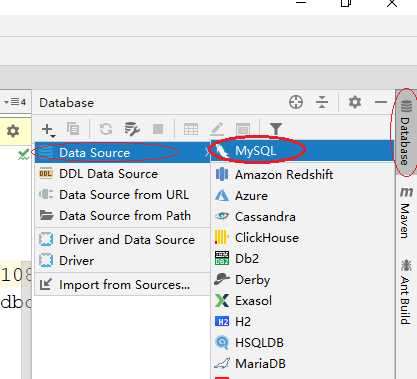
2. 填写 host、port、URL等信息后 -> TestConection(注:第一次测试连接需先安装插件)
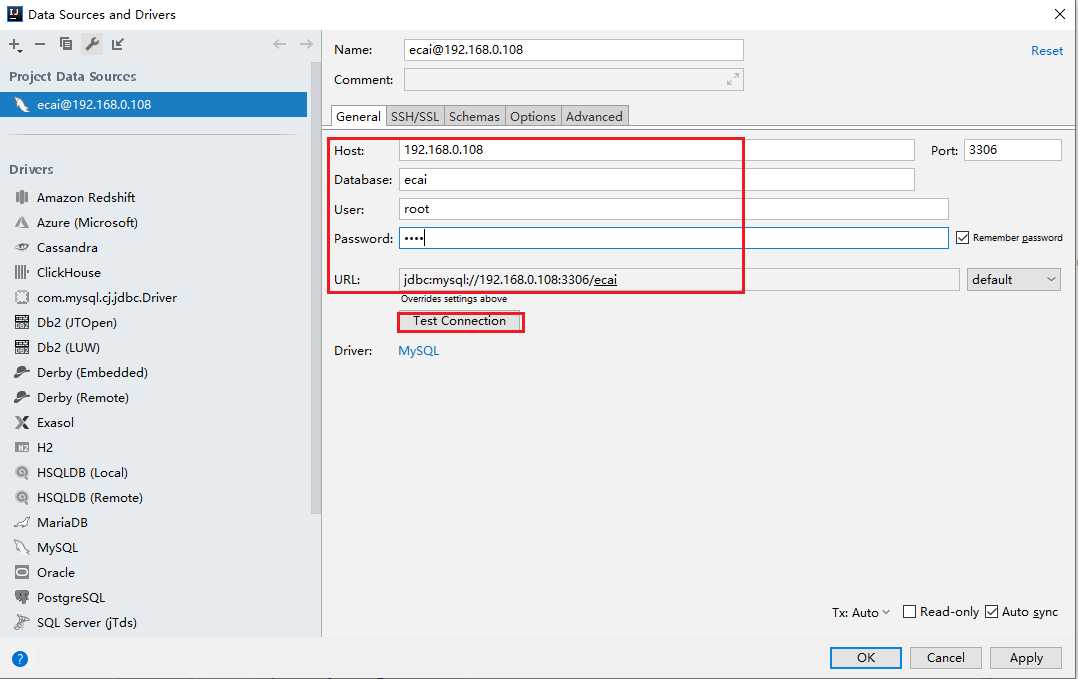
测试连接:成功
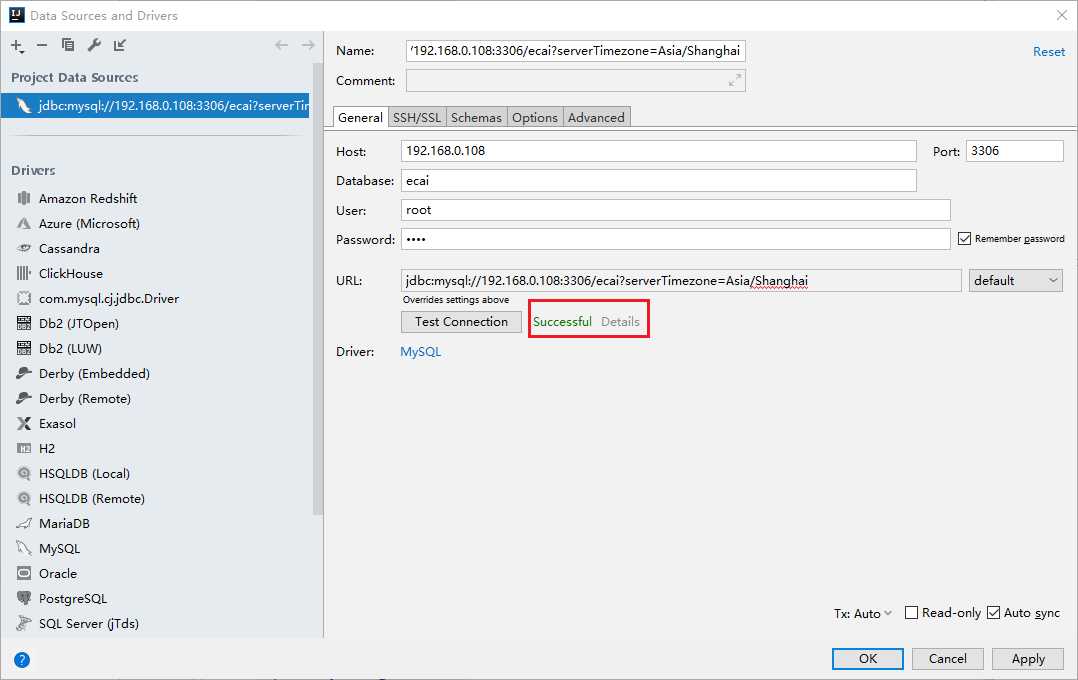
3.

4.添加hibernate配置文件

<?xml version=‘1.0‘ encoding=‘utf-8‘?> <!DOCTYPE hibernate-configuration PUBLIC "-//Hibernate/Hibernate Configuration DTD//EN" "http://www.hibernate.org/dtd/hibernate-configuration-3.0.dtd"> <hibernate-configuration> <session-factory> <!-- 主要三部分配置--> <!-- 1.配置数据库信息,必须的--> <property name="connection.url">jdbc:mysql://192.168.0.108:3306/ecai?serverTimezone=Asia/Shanghai</property> <property name="connection.driver_class">com.mysql.cj.jdbc.Driver</property> <property name="connection.username">root</property> <property name="connection.password">root</property> <!-- 2.配置hibernate信息,可选的--> <!-- 输出底层的sql语句--> <property name="hibernate.show_sql">true</property> <!-- 对底层sql进行格式化--> <property name="hibernate.format_sql">true</property> <!--配置数据的方言,如mysql中limit oracle的rownum--> <property name="hibernate.dialect">org.hibernate.dialect.MySQLDialect</property> <property name="hibernate.current_session_context_class">thread</property> <!-- 3.把映射文件配置到核心文件中,必须的--> </session-factory> </hibernate-configuration>

5. 添加hibernate配置文件成功后,左下角将出现 Persistence窗口,右击第一行的项目名
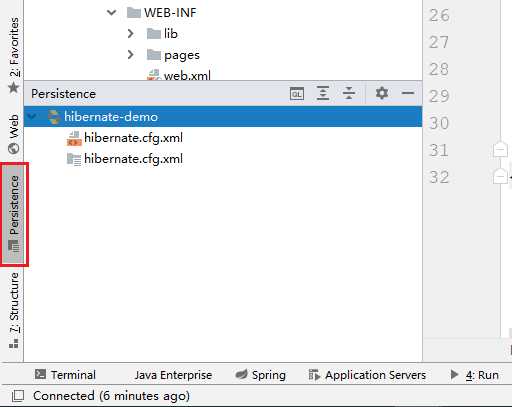
6.
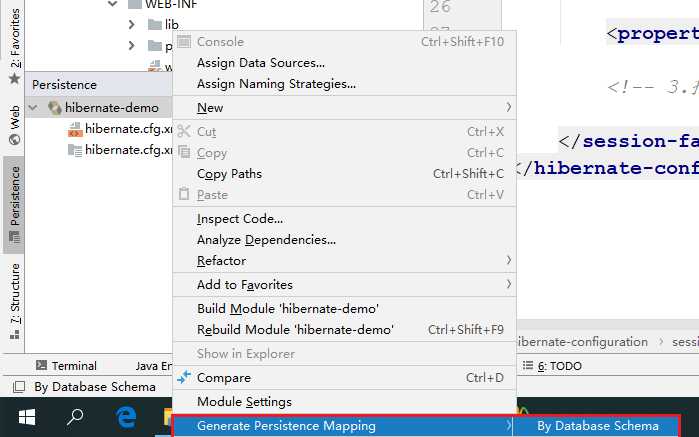
7.
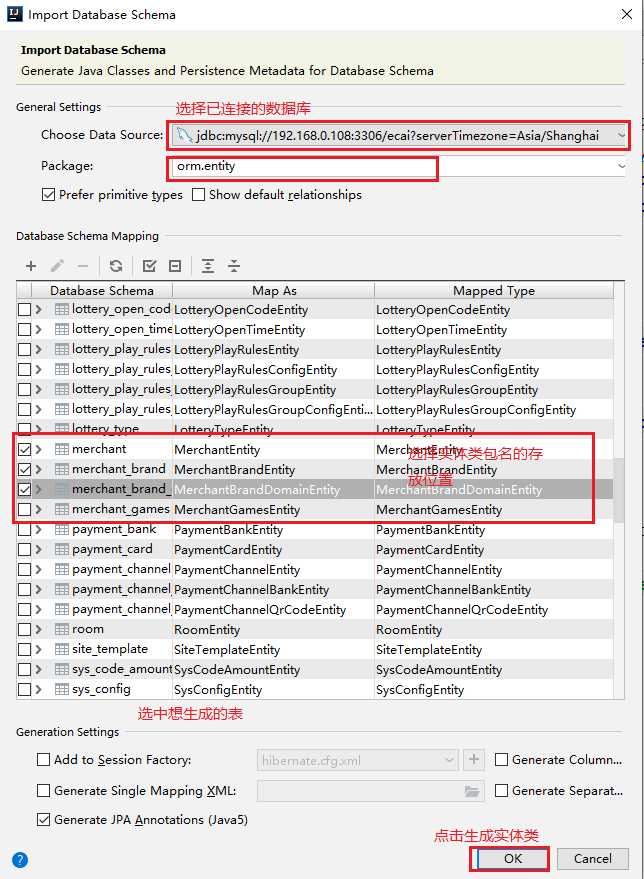
例:生成后的实体类

package orm.entity; import javax.persistence.*; import java.math.BigDecimal; /** * <p> * * </p> * * @author: zeng * @since: 2020-03-26 */ @Entity @Table(name = "merchant", schema = "ecai", catalog = "") public class MerchantEntity { private int id; private String code; private String account; private String password; private String nickname; private BigDecimal balance; private int status; private int roleId; private String secretKey; private String registTime; private String loginTime; private String loginIp; private String loginPlat; private String ips; private String phone; private String email; private String qq; private String wechat; @Id @Column(name = "id") public int getId() { return id; } public void setId(int id) { this.id = id; } @Basic @Column(name = "code") public String getCode() { return code; } public void setCode(String code) { this.code = code; } @Basic @Column(name = "account") public String getAccount() { return account; } public void setAccount(String account) { this.account = account; } @Basic @Column(name = "password") public String getPassword() { return password; } public void setPassword(String password) { this.password = password; } @Basic @Column(name = "nickname") public String getNickname() { return nickname; } public void setNickname(String nickname) { this.nickname = nickname; } @Basic @Column(name = "balance") public BigDecimal getBalance() { return balance; } public void setBalance(BigDecimal balance) { this.balance = balance; } @Basic @Column(name = "status") public int getStatus() { return status; } public void setStatus(int status) { this.status = status; } @Basic @Column(name = "role_id") public int getRoleId() { return roleId; } public void setRoleId(int roleId) { this.roleId = roleId; } @Basic @Column(name = "secret_key") public String getSecretKey() { return secretKey; } public void setSecretKey(String secretKey) { this.secretKey = secretKey; } @Basic @Column(name = "regist_time") public String getRegistTime() { return registTime; } public void setRegistTime(String registTime) { this.registTime = registTime; } @Basic @Column(name = "login_time") public String getLoginTime() { return loginTime; } public void setLoginTime(String loginTime) { this.loginTime = loginTime; } @Basic @Column(name = "login_ip") public String getLoginIp() { return loginIp; } public void setLoginIp(String loginIp) { this.loginIp = loginIp; } @Basic @Column(name = "login_plat") public String getLoginPlat() { return loginPlat; } public void setLoginPlat(String loginPlat) { this.loginPlat = loginPlat; } @Basic @Column(name = "ips") public String getIps() { return ips; } public void setIps(String ips) { this.ips = ips; } @Basic @Column(name = "phone") public String getPhone() { return phone; } public void setPhone(String phone) { this.phone = phone; } @Basic @Column(name = "email") public String getEmail() { return email; } public void setEmail(String email) { this.email = email; } @Basic @Column(name = "qq") public String getQq() { return qq; } public void setQq(String qq) { this.qq = qq; } @Basic @Column(name = "wechat") public String getWechat() { return wechat; } public void setWechat(String wechat) { this.wechat = wechat; } @Override public boolean equals(Object o) { if (this == o) return true; if (o == null || getClass() != o.getClass()) return false; MerchantEntity that = (MerchantEntity) o; if (id != that.id) return false; if (status != that.status) return false; if (roleId != that.roleId) return false; if (code != null ? !code.equals(that.code) : that.code != null) return false; if (account != null ? !account.equals(that.account) : that.account != null) return false; if (password != null ? !password.equals(that.password) : that.password != null) return false; if (nickname != null ? !nickname.equals(that.nickname) : that.nickname != null) return false; if (balance != null ? !balance.equals(that.balance) : that.balance != null) return false; if (secretKey != null ? !secretKey.equals(that.secretKey) : that.secretKey != null) return false; if (registTime != null ? !registTime.equals(that.registTime) : that.registTime != null) return false; if (loginTime != null ? !loginTime.equals(that.loginTime) : that.loginTime != null) return false; if (loginIp != null ? !loginIp.equals(that.loginIp) : that.loginIp != null) return false; if (loginPlat != null ? !loginPlat.equals(that.loginPlat) : that.loginPlat != null) return false; if (ips != null ? !ips.equals(that.ips) : that.ips != null) return false; if (phone != null ? !phone.equals(that.phone) : that.phone != null) return false; if (email != null ? !email.equals(that.email) : that.email != null) return false; if (qq != null ? !qq.equals(that.qq) : that.qq != null) return false; if (wechat != null ? !wechat.equals(that.wechat) : that.wechat != null) return false; return true; } @Override public int hashCode() { int result = id; result = 31 * result + (code != null ? code.hashCode() : 0); result = 31 * result + (account != null ? account.hashCode() : 0); result = 31 * result + (password != null ? password.hashCode() : 0); result = 31 * result + (nickname != null ? nickname.hashCode() : 0); result = 31 * result + (balance != null ? balance.hashCode() : 0); result = 31 * result + status; result = 31 * result + roleId; result = 31 * result + (secretKey != null ? secretKey.hashCode() : 0); result = 31 * result + (registTime != null ? registTime.hashCode() : 0); result = 31 * result + (loginTime != null ? loginTime.hashCode() : 0); result = 31 * result + (loginIp != null ? loginIp.hashCode() : 0); result = 31 * result + (loginPlat != null ? loginPlat.hashCode() : 0); result = 31 * result + (ips != null ? ips.hashCode() : 0); result = 31 * result + (phone != null ? phone.hashCode() : 0); result = 31 * result + (email != null ? email.hashCode() : 0); result = 31 * result + (qq != null ? qq.hashCode() : 0); result = 31 * result + (wechat != null ? wechat.hashCode() : 0); return result; } }
以上是关于idea 自动生成 hibernate 实体类的主要内容,如果未能解决你的问题,请参考以下文章
在Idea中自动生成实体类和hibernate.cfg.xml文件
